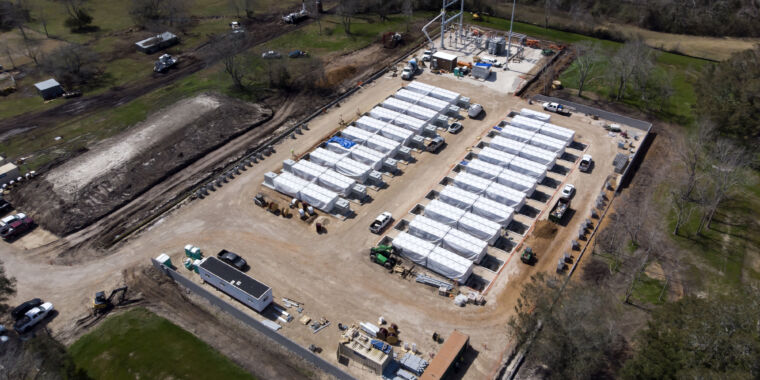-
A sign says “Gambit Construction Entrance” at a construction site outside Angleton, Texas, on March 4, 2021.
Mark Felix / Bloomberg via Getty Images
-
The sheets cover the equipment at the Gambit Energy Storage Park.
Mark Felix / Bloomberg via Getty Images
-
A contractor walks through the Gambit Energy Storage Park.
Mark Felix / Bloomberg via Getty Images
-
An aerial view of the site shows 20 large batteries.
Mark Felix / Bloomberg via Getty Images
-
Another aerial view of the place.
Mark Felix / Bloomberg via Getty Images
-
A page about the project on the Angleton website includes a photo of a Tesla battery case.
Plus Power
Tesla is best known as an electric car company, but the company also has a thriving battery storage business – including utility-scale battery installations to support the power grid. Bloomberg reports that Tesla is currently building a battery installation in the new home state of Tesla’s CEO, Elon Musk, Texas. The project is in Angleton, about an hour south of Houston.
Tesla did not disclose the project, which is operating under the name of an obscure Tesla subsidiary called Gambit Energy Storage LLC. When a Bloomberg photographer visited, a worker discouraged taking photos and said the project was “secret”. The project appears to consist of 20 large battery banks that have been covered with white sheets.
A document on the website of the city of Angleton provides some details about the project. It is listed as a Plus Power project, but includes a photo of a Tesla battery case. Plus Power has two former Tesla employees among its executives. In addition, he confirmed to Bloomberg that he had started the project, then sold it to an undisclosed party.
The facility will use lithium iron phosphate batteries that are expected to last 10 to 20 years. The document says it will generate about $ 1 million in property tax revenue for the city of Angleton. The site will be unguarded, but it will be monitored remotely at all times, according to the document.
Texas has its own power grid supervised by the Texas Electric Reliability Council. “Angleton forms an especially volatile ‘knot’ in the ERCOT power grid and the larger system will benefit from the energy balancing properties that the battery can provide,” says the document.
The Texas power grid received a lot of attention in February, after an exceptionally cold climate left much of the state without power for several days. On a sarcastic tweet last month, Musk wrote that “ERCOT is not winning that R.”
And Musk has many reasons to be concerned about the quality of the power grid in Texas. Not only has Musk recently moved to the state, but his two companies – SpaceX and Tesla – are expanding their presence there. Tesla is building a car factory in the Austin area. SpaceX has long had a test facility in McGregor, Texas, halfway between Austin and Dallas. More recently, SpaceX has injected resources into its launch facility in Boca Chica, in the extreme south of the state.
An ERCOT employee told Bloomberg that the covert facility has a proposed commercial operation date of June 1, so it may be nearing completion.
In 2017, we covered Tesla’s construction of a huge battery installation in South Australia. At the time, the 100 MW system was the largest in the world. According to Bloomberg, Texas’ new battery system will be at least as big.
In the long run, huge battery installations will be needed to transfer intermittent solar and wind energy over time. But many battery installations today do not have enough capacity to do much of that. Tesla’s battery in South Australia, for example, only had enough capacity to supply power for just over an hour at its total power level of 100 MW.
Instead, the first utility-scale batteries are being used to smooth short-term fluctuations and keep the power supply perfectly balanced with demand. If a power plant fails unexpectedly or demand suddenly increases, a utility-scale battery can provide a few minutes of power while utility companies make the necessary adjustments.
Concessionaires traditionally deal with this by having plants powered by natural gas in standby mode 24 hours a day, 7 days a week. Since these “peak power plants” can only be used for a few hours a year, the energy they produce is extremely expensive per kilowatt. Batteries can absorb excess energy at times when it is plentiful and then release it at peak demand times, allowing electricity utilities to shut down some of their peak gas-powered plants without compromising the reliability of the network.
As batteries become cheaper, it will be more economical to install even larger batteries to balance supply and demand on a 24-hour cycle, allowing utilities to rely more on solar and wind energy. That’s why analysts expect large-scale batteries to be a fast-growing market in the next two decades; you will need a lot more storage capacity to decarbonize the power grid.
Listing image by Mark Felix / Bloomberg via Getty Images
